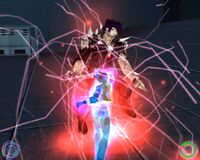Oni (myth): Difference between revisions
m (+link to disambig page) |
|||
| (97 intermediate revisions by 5 users not shown) | |||
| Line 1: | Line 1: | ||
{| | {{Hatnote|This article is about the Japanese myth. For our other "Oni" articles, see [[Oni (disambiguation)]].}} | ||
| | {|style="float:right" | ||
|[[Image:Oni kanji.jpg|thumb|300px|Bungie's rendition of the ''oni'' [[wp:Kanji|kanji]]. The Chinese reading is ''guǐ'' (ghost), considered at the bottom of the article.]] | |||
|} | |} | ||
The name of Bungie's game '''[[Oni]]''' was intended as a reference to the game's inspiration, [[Ghost in the Shell]], though it turned out that the Japanese kanji 鬼 does not accurately translate as "ghost". First we'll look at the actual meaning of the word by examining the myths of oni in Japanese folklore, then we'll consider some ways in which these true meanings of the word might appear in the game. | |||
==Traditional depictions of oni== | |||
== | Many people give the translation for "oni" as "demon", but below we examine more accurate terms for the various depictions of oni in Japanese stories. On the whole, it will be seen that a modern oni is always some kind of minor evil ''in the flesh'' that afflicts, threatens, or sometimes even ignores humans. This is in contrast to the usual use of the word "demon" in English, which refers to the fallen angels in the Bible, who are immaterial and who can possess humans. In fact, a much closer translation, looking at the Eastern depictions of an oni, would be "ogre", "beast" or "monster", but not "demon", which more closely corresponds to the Japanese word "akuma" ("evil being"). | ||
===Imps=== | |||
In traditional Buddhist-Japanese mythology, the oni are the exact counterparts of Christian imps (or devils with a small D). Some would guard the gates of Buddhist hell, while others would hunt down bad people and bring them ''to'' hell, and others would actually torture the bad people ''in'' hell. It's exactly what Christian imps do, so it's a pretty exact analogy. Recurrent features of oni were somewhat improbable skin color, two small horns on the forehead, a big club (imps have forks instead), and they were dressed in tiger skins. The iron club is called a kanabō. | |||
===Ghosts=== | |||
Before the influence of Buddhism, oni may have been depicted as immaterial spirits like the [[wp:Yūrei|yurei]], which needed to be driven out through [[wp:Onmyōdō|yin-yang magic]]. Instead of being the "official enforcers of the underworld", they would infest sacred places and prey on humans. However, the concept of oni eventually crystallized into a more solid form. | |||
===Ogres=== | |||
The theme of the monstrous, man-like enemy that must be slain by samurai or a demon-hunter resembles Western (Greek, Medieval, Slavic) heroes and the mythological beasts they were said to have slain. As opposed to the Buddhist "imps" or the Shinto "ghosts", this is more secular mythology, closer to the fantasy genre than a moral tale belonging to religion. | |||
An example is found in [http://web.archive.org/web/20090814100526/http://www.kyoto.zaq.ne.jp/mibu/eng/pages/plays/tales.html#Anchor-Ogre-43793 one of the stories] of the demon hunter Raiko. While in Kyoto, he and his five greatest knights hear tell of an oni that preys on travelers near the great gate Rashoumon, the southern gate on the main road through Kyoto. One of his retainers, Watanabe, volunteers to see if this is true, and if so, slay the oni and hang a talisman with all of their names on the gate's handle. Sure enough, he encounters an oni there, but only succeeds in severing one of its arms and driving it off. | |||
===Ogre-like men=== | |||
[[Image:Earthquake_(Samurai_Shodown)_ZBrush_model_(clay).jpg|thumb|200px|<strike>Earthquake</strike> [[Oni2:Big|Mr. Big]], an ogre-like character for Oni 2 (geyser's take), reminiscent of Musashibo Benkei.]] | |||
{| | Occasionally people of exceptional size and/or strength can be described as "oni". The most notable such figure in Japanese folklore is (Saitō) Musashibō Benkei, a large warrior monk who lived in the late XII century. | ||
| | |||
Apart from tales of his conflicted loyalty as a servant of samurai Minamoto no Yoshitsune, Benkei's uncommon size and strength gave rise to folkloric accounts of incredible feats, both in his youth and as a grown man. Benkei's birth and childhood, in particular, are heavily laden with myth and intertwined with tales of the demon child "Oniwakamaru" (Benkei himself was apparently called '''Oniwaka 鬼若''' in his young years); one such tale is the one of Oniwakamaru (young Benkei) fighting a giant carp fish. Benkei's death is remarkably iconic and demon-like as well: unbeatable in close combat, he was ridden with arrows from afar and allegedly died standing, scaring off his enemies long after his heart had ceased to beat. | |||
Beyond the heavily exaggerated Oniwakamura myth, the oni theme persists in depictions of Benkei's adolescence, most notably in the [https://www.surlalunefairytales.com/books/japan/griffis/benkeibell.html Mii-dera bell episode], where he playfully stole a large bell from a rival monastery, brought it to his own, and later threw the bell away because it gave out a nostalgic ring (as if saying "I want to go back"). In some accounts Benkei is shown dragging the bell along with a rope, but in many others he is carrying the huge bell on his back, sometimes using a large metal bar for leverage as in the account linked above. In several depictions, this iron bar is pictured to be Benkei's own weapon, a "kanabō 金棒", and Benkei himself is pictured as a hulking monster of a man, with lots of hair and muscle. Arguably [https://www.britishmuseum.org/collection/object/A_1906-1220-0-1054 THIS] drawing of the Mii-dera bell episode is the most herculean/oni-like rendition of Benkei. | |||
Last but not least, Benkei's legendary affinity for powerful weapons has evolved into a myth of its own: "Benkei's seven tools" that are often displayed on Benkei's back. Along with an ordinary sword, the aforementioned kanabō or tetsubō (iron club) and the naginata typical of warrior monks (a lance with a crescent-shaped blade), the seven tools can include: an axe (masakari), a rake (kumade), a saw (nokogiri), a sickle (nagigama) and a mallet (hizuchi). On a perhaps unrelated note, it is Benkei's playful quest for collecting 1000 samurai swords that led to his fight with Yoshitsune, following which Benkei was humbled and served the rest of his life as Yoshitsune's "retainer". | |||
===Aliens=== | |||
As seen in contemporary anime, Japan's view of the oni has mellowed somewhat; oni might simply be immortal, aloof, selfish beings, superior to humans but with no clear intentions about them. In some cases they are clearly depicted like Western ogres. | |||
Some oblivious, some malicious, some downright malevolent. Some, however, could feel sympathy or pity for the humans and defend them against a greater evil (end-of-all-worlds kind). But mostly they're just outsiders, aliens in the mortal world. | |||
A classic modern example of oni is found in [[wp:Urusei Yatsura|Urusei Yatsura]], where Lum (pictured below) and her relatives are aliens (an alien race literally called "Oni") who are sent to (fairly benevolently) conquer Earth. Their powers include flying, breathing fire, and shocking electrically. Lum has the typical two horns of an oni, but they're mostly hidden by her hair. | |||
===Satire=== | |||
Occasionally the modern take on oni is a bit more satirical, as in the case of George Saotome from [[wp:YuYu Hakusho|Yu Yu Hakusho]], who appears to be a traditional monstrous oni in tiger skins, but who is actually a mild-mannered, harried office worker assisting the ruler of Spirit World. In [[wp:Dragon Ball Z|Dragon Ball Z]], while traveling through the afterlife, Goku accidentally falls into Hell and encounters Goz and Mez, who challenge him to physical competitions (you see, Hell is an eternal gym class). They display the traditional red and blue coloring and have one and two horns, as well as carrying kanabō. Their names come directly from [https://yokai.com/mezu/ this Gozu and Mezu]. | |||
{|class="wikitable" style="margin-left:auto; margin-right:auto;" | |||
|- | |||
|[[Image:Lum from Urusei Yatsura.jpg|200px]] | |||
|[[Image:George from Yu Yu Hakusho.jpg|200px]] | |||
|[[Image:Goz and Mez from Dragon Ball Z.jpg|200px]] | |||
|- | |||
|<center>Lum (''Urusei Yatsura'')</center> | |||
|<center>George (''YuYu Hakusho'')</center> | |||
|<center>Goz and Mez (''Dragon Ball Z'')</center> | |||
|} | |} | ||
===Further reading=== | |||
*[[wp:Oni|Oni folklore on Wikipedia]] | |||
*[http://www.sonic.net/~anomaly/oniko/eprofile.htm Oniko's Gallery]; draws the connections between Buddhist oni and the ones in contemporary anime | |||
*and a [https://web.archive.org/web/20140828132113/http://japanese.about.com/library/weekly/aa110400.htm lot] [https://www.artelino.com/articles/japanese_mythology.asp more] | |||
---- | ==Meaning in Slavic languages== | ||
For the Russian distribution [[:Image:Windows (RU) jewel case - front.jpg|Oni's title was transliterated into Cyrillic characters]], but this also spells a word in Russian meaning "them". Thus some Russian gamers, instead of reading the title phonetically, assumed that the game is actually called "Them", which just so happens to convey the same creepy ambiguity as "Oni". Most of the other Slavic languages, such as Polish and Czech, also use "oni" for "them" or "they", creating the same potential for confusion as in Russian. | |||
==Connections to the game== | |||
{{SysopAdvice|I think [[Konoko|Oni]] is a pretty cool guǐ. Seh fights [[Strikers|Stirkers]] and doesn't afraid of anything.|Don't listen to that guǐ.}} | |||
As explained in Bungie.org's [http://oni.bungie.org/special/part1/brent.html interview with Brent Pease], "Oni" was originally going to be the game's code name during development, as a reference to his inspiration, [[Ghost in the Shell]]. It started with Pease, who formulated the idea for the game, asking his girlfriend the Japanese word for "ghost" because she was studying Japanese at the time. | |||
However it turned out that the Japanese word ''oni'' (鬼) does not accurately translate as "ghost", and is used more typically for monsters-in-the-flesh which could be called ogres or demons. Oni's design lead Hardy LeBel came to understand the proper meaning(s) of the word and [http://carnage.bungie.org/oniforum/oni.forum.pl?read=19851 explained here] that he attempted to justify the title of the game in the final story (as he also made sure to justify the game's tagline, "A dark future… an uncertain past… no one left to trust"). | |||
===Monsters=== | |||
It appears that one definition of "oni" that Hardy leaned towards was "monster". If one searches [[Quotes/Speech|Oni's dialogue]] for "monster", a theme develops from the five occurrences of the term. | |||
First, Barabas is described as a '''monster''' (see "Barabas" section below to see how Hardy applied myths about the oni to Barabas). Then Konoko describes Muro and his men as '''monsters''', fearful that the Chrysalis will do the same to her. During her attack on the TCTF HQ, Konoko tells an unnamed NPC that she was made into a '''monster''' when she was implanted with the Chrysalis. But Konoko has not fully decided whether she is any better than Muro and his men until the point at which the player has to decide whether to kill Griffin. Each scenario, sparing him and killing him, uses the word "monster". If she spares Griffin, Konoko says that she won't be "the '''monster''' you thought I would be". If she kills Griffin, Konoko puts the blame on him for her actions, calling ''him'' a '''monster''' for what he did to her. | |||
Finally, though the game refers to him as "Mutant" Muro, Muro's transformation in the killed-Griffin scenario is certainly monstrous, and no doubt intended to reflect Konoko's own choice to take Griffin's life and what that might portend for her development as a symbiote. | |||
===Ghosts=== | |||
The plot of [[:Category:Dark Horse comics|Dark Horse's comic book series]] incorporates the originally-understood meaning of "oni", "ghosts". Thus, in the synopsis for [https://www.darkhorse.com/Comics/00-238/Rockstar-Games-Oni-1-of-3 issue #1], "Syndicate thieves have been spreading rumors of a ghost-like entity that attacks them after successful jobs and steals their loot." In issues [https://www.darkhorse.com/Comics/00-244/Rockstar-Games-Oni-2-of-3 #2] and [https://www.darkhorse.com/Comics/00-252/Rockstar-Games-Oni-3-of-3 #3], "mysterious 'ghosts' are plaguing Syndicate operations, and Agent Konoko, while investigating the Syndicate, finds out what these 'ghosts' are." | |||
Hardy may also have paid tribute to the "original" meaning of the word with one "ghost" in the dialogue ([[Quotes/Speech#Intro 4|in reference to Prof. Hasegawa]]) and two mentions of 'ghost signals' in the console text ([[Quotes/Consoles#Deadly Brain : Weaknesses|sending them to the Deadly Brain]] and [[Quotes/Consoles#Malfunctioning Atmospheric Processor|detecting them in the ACCs]]). | |||
===Demons=== | |||
Bungie West might have been acknowledging what is probably the most common translation given for "oni" (even if it's not the most accurate), "demon", when they named one of Konoko's super moves "Devil Spin Kick". | |||
===Red oni & blue oni=== | |||
As TV Tropes explains [https://tvtropes.org/pmwiki/pmwiki.php/Main/RedOniBlueOni here], oni are most often depicted as red and blue. Over time, personalities were associated with these colors and used as character tropes. Normally the red-oni character is the fiery one and the blue-oni character is the cool, collected one. It's probably worth noting here that Konoko's Daodan aura is blue and Muro's is red ;-) | |||
===Transformation through anger=== | |||
As a Portuguese article states, "It is also said that a man with anger will transform into an oni. Japanese folklore also says that a wife of great jealousy will become a Hannya, that is, a female oni. [...] The Buddhist oni is not always an evil force; in the Buddhist legends there are stories of monks who, after death, became oni in order to protect their temples from disasters. The belief in oni reached its zenith in the 18th and 19th centuries." | |||
At the very least, this describes Mutant [[Muro]] well. For that matter, all the known [[Daodan]] symbiotes are violent individuals. Barabas is an elite Striker, and Mukade tempts [[Mai]] to come over to the dark side and 'embrace the oblivion'; Mai ends their fight with gratuitous violence. Kerr tells her later that her final form will be a manifestation of her true self, leaving us to wonder if her true self is naughty or nice, and what appearance this will result in. | |||
Incidentally, mukade are large centipedes native to Japan. Pagan mythology depicts giant versions of these things alongside gods, dragons and other beasts. As opposed to e.g. dragons, the Mukade were irredeemably vile, so of all the beast-gods they're the most likely to fall in the category of oni, super-oni even.... See [[Mukade]]'s page for more. | |||
===Barabas=== | |||
The Japanese have a saying, "oni ni kanabo", "like an oni with its iron club". The phrase conveys the concept of an already strong entity equipped with a weapon to make it even stronger. [[Barabas]] is represented as a very strong fighter, and on top of that, he has the game's biggest weapon in his hands when Konoko first confronts him. | |||
But there's more. Barabas also possesses a regenerative ability, an occasional attribute of oni, as well as horns, and to top it all off, <u>he's guarding a gate</u>, as many oni do in folk tales. Coincidence? | |||
===Muro=== | |||
[[Image:Muro blanka attack.jpg|200px|right]] | |||
Mythical oni have long been associated with thunder and lightning, and it's theorized that lightning gods, raijin, are just oni in another package (see the images of them in Wikipedia's [[wp:Raijin|Raijin article]]). As Noriko Reider's ''[https://archive.org/details/JapaneseDemonLore Japanese Demon Lore]'' states (p. 177), "For ancient and medieval Japanese cultures, […] oni were believed to be the very substance of thunder and lightning. Oni were the cause behind epidemics that killed people by the tens of thousands." Remind us again, who's our favorite epidemic-causing lightning god in Oni? | |||
===Iron Demon=== | |||
The [[Iron Demon]] is a demon too, at least in name. The "Iron" may be a reference to the kanabo, discussed in the "Barabas" section above. The Dark Horse comic runs the risk of being ''too'' on the nose by also equipping the Iron Demon with a ''[[:Image:Oni_Comic_Issue_1_p22.jpg|literal iron club]]''. | |||
==Alternate universe titles for Oni== | |||
What if Brent had received an accurate response that day as to the Japanese word for "ghost"? Well, the most common words for ghost seem to be ''youkai'', ''yurei'', ''youma'', and ''konpaku''. So in an alternate universe, it could be that we're all big "Youma" fans or avid players of "Youkai". | |||
It's probably worth pointing out here that an "ou" is one of the ways of representing the long 'o' sound in the standard [[wp:Hepburn_romanization|Hepburn romanization system]]. The sound can also be written as an 'o' with a macron: '''ō'''. Since most English speakers don't know the proper reading of "ou", they would be inclined to pronounce "youma" as "yuu-ma" when it should really be said "yoh-ma". So presumably Bungie would have ended up just writing it "Yoma" or "Yokai" to avoid confusion if Brent had used one of those words for the project's code name instead of "Oni". | |||
---- | ---- | ||
{| style="float:right; border:1px solid #BBB;margin:.46em 0 0 .2em" | |||
|+[[Oni matrix|Coincidence?]] | |||
|- | |||
| | |||
捣 - D ǎ '''''O''''' | |||
蛋 - D à '''''N''''' | |||
鬼 - G U '''''ǐ''''' | |||
<nowiki>|</nowiki> | |||
鬼 | |||
|} | |||
Alternatively, it may have made sense to call the project "Dǎo Dàn Guǐ" 捣蛋鬼 (which is Chinese for "troublemaker", or "trouble-making ghost/spirit/demon" if taking the last symbol literally/fundamentally). Appropriately echoing Shirow's "[[Ghost in the Shell|Kōkaku Kidōtai]]", such a title would have emphasized the historical source of the "oni" kanji 鬼 (referencing a language where "ghost" actually ''was'' its primary meaning), and it would also have highlighted Oni's core concept (the [[Daodan]] Chrysalis), which breaks every balance and sends the world tumbling into uncertainty. | |||
Apparently it was deemed that "Oni" was catchier and snappier (and spookier?) as a title. Admittedly, "Dǎo Dàn Guǐ" (or even "Yōkai") doesn't exactly roll off the tongue for a non-otaku, whereas "oni" is mainstream enough to have a [[wp:Oni|Wikipedia article in English]], so it's one of those Japanese words that sound exotic yet "work" without a translation. The deep ambiguity of the "Oni" title - not clearly meaning "ghost" or "demon", and not even clearly singular or plural - was another possible plus. | |||
If Bungie had settled for an English translation of "Dǎo Dàn Guǐ" instead, we could have known Oni as "Rebel Spirit(s)". Or "Stirring Demon(s)". Or "[[Restless Souls]]". | |||
[[Category:Oni influences]][[Category:Added value]] | |||
Latest revision as of 17:17, 13 April 2024
- This article is about the Japanese myth. For our other "Oni" articles, see Oni (disambiguation).
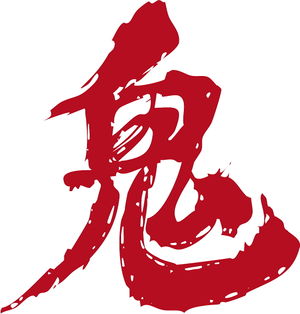 Bungie's rendition of the oni kanji. The Chinese reading is guǐ (ghost), considered at the bottom of the article. |
The name of Bungie's game Oni was intended as a reference to the game's inspiration, Ghost in the Shell, though it turned out that the Japanese kanji 鬼 does not accurately translate as "ghost". First we'll look at the actual meaning of the word by examining the myths of oni in Japanese folklore, then we'll consider some ways in which these true meanings of the word might appear in the game.
Traditional depictions of oni
Many people give the translation for "oni" as "demon", but below we examine more accurate terms for the various depictions of oni in Japanese stories. On the whole, it will be seen that a modern oni is always some kind of minor evil in the flesh that afflicts, threatens, or sometimes even ignores humans. This is in contrast to the usual use of the word "demon" in English, which refers to the fallen angels in the Bible, who are immaterial and who can possess humans. In fact, a much closer translation, looking at the Eastern depictions of an oni, would be "ogre", "beast" or "monster", but not "demon", which more closely corresponds to the Japanese word "akuma" ("evil being").
Imps
In traditional Buddhist-Japanese mythology, the oni are the exact counterparts of Christian imps (or devils with a small D). Some would guard the gates of Buddhist hell, while others would hunt down bad people and bring them to hell, and others would actually torture the bad people in hell. It's exactly what Christian imps do, so it's a pretty exact analogy. Recurrent features of oni were somewhat improbable skin color, two small horns on the forehead, a big club (imps have forks instead), and they were dressed in tiger skins. The iron club is called a kanabō.
Ghosts
Before the influence of Buddhism, oni may have been depicted as immaterial spirits like the yurei, which needed to be driven out through yin-yang magic. Instead of being the "official enforcers of the underworld", they would infest sacred places and prey on humans. However, the concept of oni eventually crystallized into a more solid form.
Ogres
The theme of the monstrous, man-like enemy that must be slain by samurai or a demon-hunter resembles Western (Greek, Medieval, Slavic) heroes and the mythological beasts they were said to have slain. As opposed to the Buddhist "imps" or the Shinto "ghosts", this is more secular mythology, closer to the fantasy genre than a moral tale belonging to religion.
An example is found in one of the stories of the demon hunter Raiko. While in Kyoto, he and his five greatest knights hear tell of an oni that preys on travelers near the great gate Rashoumon, the southern gate on the main road through Kyoto. One of his retainers, Watanabe, volunteers to see if this is true, and if so, slay the oni and hang a talisman with all of their names on the gate's handle. Sure enough, he encounters an oni there, but only succeeds in severing one of its arms and driving it off.
Ogre-like men
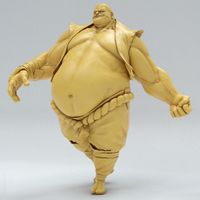
Occasionally people of exceptional size and/or strength can be described as "oni". The most notable such figure in Japanese folklore is (Saitō) Musashibō Benkei, a large warrior monk who lived in the late XII century.
Apart from tales of his conflicted loyalty as a servant of samurai Minamoto no Yoshitsune, Benkei's uncommon size and strength gave rise to folkloric accounts of incredible feats, both in his youth and as a grown man. Benkei's birth and childhood, in particular, are heavily laden with myth and intertwined with tales of the demon child "Oniwakamaru" (Benkei himself was apparently called Oniwaka 鬼若 in his young years); one such tale is the one of Oniwakamaru (young Benkei) fighting a giant carp fish. Benkei's death is remarkably iconic and demon-like as well: unbeatable in close combat, he was ridden with arrows from afar and allegedly died standing, scaring off his enemies long after his heart had ceased to beat.
Beyond the heavily exaggerated Oniwakamura myth, the oni theme persists in depictions of Benkei's adolescence, most notably in the Mii-dera bell episode, where he playfully stole a large bell from a rival monastery, brought it to his own, and later threw the bell away because it gave out a nostalgic ring (as if saying "I want to go back"). In some accounts Benkei is shown dragging the bell along with a rope, but in many others he is carrying the huge bell on his back, sometimes using a large metal bar for leverage as in the account linked above. In several depictions, this iron bar is pictured to be Benkei's own weapon, a "kanabō 金棒", and Benkei himself is pictured as a hulking monster of a man, with lots of hair and muscle. Arguably THIS drawing of the Mii-dera bell episode is the most herculean/oni-like rendition of Benkei.
Last but not least, Benkei's legendary affinity for powerful weapons has evolved into a myth of its own: "Benkei's seven tools" that are often displayed on Benkei's back. Along with an ordinary sword, the aforementioned kanabō or tetsubō (iron club) and the naginata typical of warrior monks (a lance with a crescent-shaped blade), the seven tools can include: an axe (masakari), a rake (kumade), a saw (nokogiri), a sickle (nagigama) and a mallet (hizuchi). On a perhaps unrelated note, it is Benkei's playful quest for collecting 1000 samurai swords that led to his fight with Yoshitsune, following which Benkei was humbled and served the rest of his life as Yoshitsune's "retainer".
Aliens
As seen in contemporary anime, Japan's view of the oni has mellowed somewhat; oni might simply be immortal, aloof, selfish beings, superior to humans but with no clear intentions about them. In some cases they are clearly depicted like Western ogres. Some oblivious, some malicious, some downright malevolent. Some, however, could feel sympathy or pity for the humans and defend them against a greater evil (end-of-all-worlds kind). But mostly they're just outsiders, aliens in the mortal world.
A classic modern example of oni is found in Urusei Yatsura, where Lum (pictured below) and her relatives are aliens (an alien race literally called "Oni") who are sent to (fairly benevolently) conquer Earth. Their powers include flying, breathing fire, and shocking electrically. Lum has the typical two horns of an oni, but they're mostly hidden by her hair.
Satire
Occasionally the modern take on oni is a bit more satirical, as in the case of George Saotome from Yu Yu Hakusho, who appears to be a traditional monstrous oni in tiger skins, but who is actually a mild-mannered, harried office worker assisting the ruler of Spirit World. In Dragon Ball Z, while traveling through the afterlife, Goku accidentally falls into Hell and encounters Goz and Mez, who challenge him to physical competitions (you see, Hell is an eternal gym class). They display the traditional red and blue coloring and have one and two horns, as well as carrying kanabō. Their names come directly from this Gozu and Mezu.
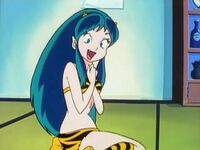
|
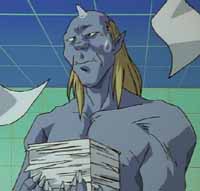
|
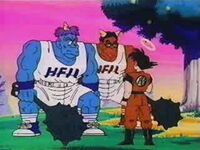
|
Further reading
- Oni folklore on Wikipedia
- Oniko's Gallery; draws the connections between Buddhist oni and the ones in contemporary anime
- and a lot more
Meaning in Slavic languages
For the Russian distribution Oni's title was transliterated into Cyrillic characters, but this also spells a word in Russian meaning "them". Thus some Russian gamers, instead of reading the title phonetically, assumed that the game is actually called "Them", which just so happens to convey the same creepy ambiguity as "Oni". Most of the other Slavic languages, such as Polish and Czech, also use "oni" for "them" or "they", creating the same potential for confusion as in Russian.
Connections to the game
|
As explained in Bungie.org's interview with Brent Pease, "Oni" was originally going to be the game's code name during development, as a reference to his inspiration, Ghost in the Shell. It started with Pease, who formulated the idea for the game, asking his girlfriend the Japanese word for "ghost" because she was studying Japanese at the time.
However it turned out that the Japanese word oni (鬼) does not accurately translate as "ghost", and is used more typically for monsters-in-the-flesh which could be called ogres or demons. Oni's design lead Hardy LeBel came to understand the proper meaning(s) of the word and explained here that he attempted to justify the title of the game in the final story (as he also made sure to justify the game's tagline, "A dark future… an uncertain past… no one left to trust").
Monsters
It appears that one definition of "oni" that Hardy leaned towards was "monster". If one searches Oni's dialogue for "monster", a theme develops from the five occurrences of the term.
First, Barabas is described as a monster (see "Barabas" section below to see how Hardy applied myths about the oni to Barabas). Then Konoko describes Muro and his men as monsters, fearful that the Chrysalis will do the same to her. During her attack on the TCTF HQ, Konoko tells an unnamed NPC that she was made into a monster when she was implanted with the Chrysalis. But Konoko has not fully decided whether she is any better than Muro and his men until the point at which the player has to decide whether to kill Griffin. Each scenario, sparing him and killing him, uses the word "monster". If she spares Griffin, Konoko says that she won't be "the monster you thought I would be". If she kills Griffin, Konoko puts the blame on him for her actions, calling him a monster for what he did to her.
Finally, though the game refers to him as "Mutant" Muro, Muro's transformation in the killed-Griffin scenario is certainly monstrous, and no doubt intended to reflect Konoko's own choice to take Griffin's life and what that might portend for her development as a symbiote.
Ghosts
The plot of Dark Horse's comic book series incorporates the originally-understood meaning of "oni", "ghosts". Thus, in the synopsis for issue #1, "Syndicate thieves have been spreading rumors of a ghost-like entity that attacks them after successful jobs and steals their loot." In issues #2 and #3, "mysterious 'ghosts' are plaguing Syndicate operations, and Agent Konoko, while investigating the Syndicate, finds out what these 'ghosts' are."
Hardy may also have paid tribute to the "original" meaning of the word with one "ghost" in the dialogue (in reference to Prof. Hasegawa) and two mentions of 'ghost signals' in the console text (sending them to the Deadly Brain and detecting them in the ACCs).
Demons
Bungie West might have been acknowledging what is probably the most common translation given for "oni" (even if it's not the most accurate), "demon", when they named one of Konoko's super moves "Devil Spin Kick".
Red oni & blue oni
As TV Tropes explains here, oni are most often depicted as red and blue. Over time, personalities were associated with these colors and used as character tropes. Normally the red-oni character is the fiery one and the blue-oni character is the cool, collected one. It's probably worth noting here that Konoko's Daodan aura is blue and Muro's is red ;-)
Transformation through anger
As a Portuguese article states, "It is also said that a man with anger will transform into an oni. Japanese folklore also says that a wife of great jealousy will become a Hannya, that is, a female oni. [...] The Buddhist oni is not always an evil force; in the Buddhist legends there are stories of monks who, after death, became oni in order to protect their temples from disasters. The belief in oni reached its zenith in the 18th and 19th centuries."
At the very least, this describes Mutant Muro well. For that matter, all the known Daodan symbiotes are violent individuals. Barabas is an elite Striker, and Mukade tempts Mai to come over to the dark side and 'embrace the oblivion'; Mai ends their fight with gratuitous violence. Kerr tells her later that her final form will be a manifestation of her true self, leaving us to wonder if her true self is naughty or nice, and what appearance this will result in.
Incidentally, mukade are large centipedes native to Japan. Pagan mythology depicts giant versions of these things alongside gods, dragons and other beasts. As opposed to e.g. dragons, the Mukade were irredeemably vile, so of all the beast-gods they're the most likely to fall in the category of oni, super-oni even.... See Mukade's page for more.
Barabas
The Japanese have a saying, "oni ni kanabo", "like an oni with its iron club". The phrase conveys the concept of an already strong entity equipped with a weapon to make it even stronger. Barabas is represented as a very strong fighter, and on top of that, he has the game's biggest weapon in his hands when Konoko first confronts him.
But there's more. Barabas also possesses a regenerative ability, an occasional attribute of oni, as well as horns, and to top it all off, he's guarding a gate, as many oni do in folk tales. Coincidence?
Muro
Mythical oni have long been associated with thunder and lightning, and it's theorized that lightning gods, raijin, are just oni in another package (see the images of them in Wikipedia's Raijin article). As Noriko Reider's Japanese Demon Lore states (p. 177), "For ancient and medieval Japanese cultures, […] oni were believed to be the very substance of thunder and lightning. Oni were the cause behind epidemics that killed people by the tens of thousands." Remind us again, who's our favorite epidemic-causing lightning god in Oni?
Iron Demon
The Iron Demon is a demon too, at least in name. The "Iron" may be a reference to the kanabo, discussed in the "Barabas" section above. The Dark Horse comic runs the risk of being too on the nose by also equipping the Iron Demon with a literal iron club.
Alternate universe titles for Oni
What if Brent had received an accurate response that day as to the Japanese word for "ghost"? Well, the most common words for ghost seem to be youkai, yurei, youma, and konpaku. So in an alternate universe, it could be that we're all big "Youma" fans or avid players of "Youkai".
It's probably worth pointing out here that an "ou" is one of the ways of representing the long 'o' sound in the standard Hepburn romanization system. The sound can also be written as an 'o' with a macron: ō. Since most English speakers don't know the proper reading of "ou", they would be inclined to pronounce "youma" as "yuu-ma" when it should really be said "yoh-ma". So presumably Bungie would have ended up just writing it "Yoma" or "Yokai" to avoid confusion if Brent had used one of those words for the project's code name instead of "Oni".
捣 - D ǎ O
蛋 - D à N
鬼 - G U ǐ
|
鬼
|
Alternatively, it may have made sense to call the project "Dǎo Dàn Guǐ" 捣蛋鬼 (which is Chinese for "troublemaker", or "trouble-making ghost/spirit/demon" if taking the last symbol literally/fundamentally). Appropriately echoing Shirow's "Kōkaku Kidōtai", such a title would have emphasized the historical source of the "oni" kanji 鬼 (referencing a language where "ghost" actually was its primary meaning), and it would also have highlighted Oni's core concept (the Daodan Chrysalis), which breaks every balance and sends the world tumbling into uncertainty.
Apparently it was deemed that "Oni" was catchier and snappier (and spookier?) as a title. Admittedly, "Dǎo Dàn Guǐ" (or even "Yōkai") doesn't exactly roll off the tongue for a non-otaku, whereas "oni" is mainstream enough to have a Wikipedia article in English, so it's one of those Japanese words that sound exotic yet "work" without a translation. The deep ambiguity of the "Oni" title - not clearly meaning "ghost" or "demon", and not even clearly singular or plural - was another possible plus.
If Bungie had settled for an English translation of "Dǎo Dàn Guǐ" instead, we could have known Oni as "Rebel Spirit(s)". Or "Stirring Demon(s)". Or "Restless Souls".
